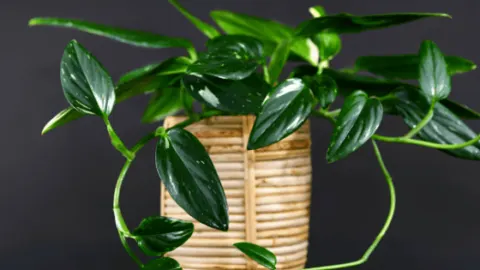The Monstera standleyana (also known as the Five Holes Plant) is a gorgeous climber plant. It has colorful variegated leaves and even holes.
One of these plants will twist up your indoor trellis. Or the vines hang from your hanging pot. It sprouts the holey leaves every plant lover has come to cherish.
The Monstera standleyana is often confused with the Philodendron. This is due to their variegated leaves.
But with the right eye, you’ll see the differences. Some people call this plant Philodendron cobra.
However, Monstera standleyana is the only correct taxonomy according to the University of Minnesota.
Interestingly, the word Monstera is Latin for the word “monster”.
This genus name was chosen to describe the original leaves with their holes and slits.
It’s these leaves on the Monstera standleyana that make the plant so special.
The tropical plant comes from the exotic country of Costa Rica, full of beaches and jungles. It also originates from Nicaragua, Honduras, and Panama.
We love this intriguing plant and we know you will too.
We are sharing our ultimate guide on the Monstera strandleyana. We want to help all the plantophiles out there that want to try their hand at this fun plant.
So, it’s time to get down and dirty with the Monstera standleyana!
Monstera standleyana Care
To care for a Monstera standleyana provide well-draining soil using orchid bark, perlite, peat moss, and charcoal and bright indirect sunlight. Water when the top 2” (5cm) of soil dry out and provide a temperature within 65-80°F (18 – 27°C). A humidity >50% and regular fertilizer once a month in the growing season.
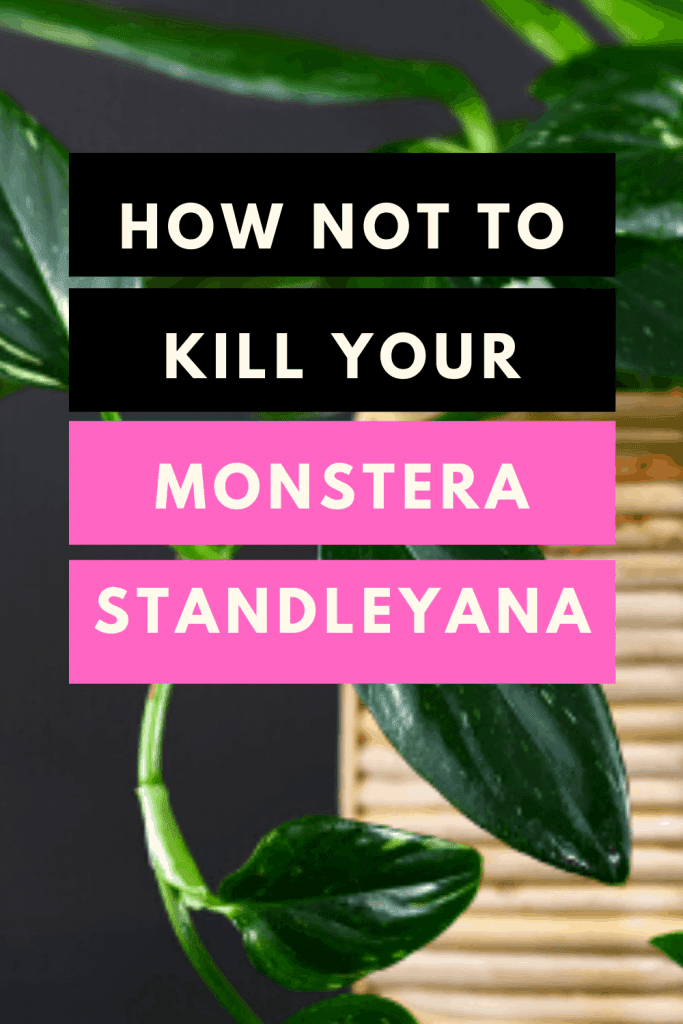
Monstera standleyana Care
Table of Contents
Monstera standleyana Care Guide
(Find our full Plant Care Sheet at the end of this article)
Soil
Monstera standleyana plants like well-draining soil using chunky ingredients such as orchid bark, perlite, peat moss and charcoal.
Well-draining soil is pretty much as it sounds.
It’s soil that allows water to drain through at a moderate rate. It doesn’t drain too fast or too slow.
If the plant’s roots receive too much water, they’re going to get waterlogged and develop wet feet.
Wet feet always lead to rot which leads to the death of your plant.
Another aspect to consider is that the plant’s roots need oxygen. When the soil is too thick and doesn’t drain well, it can cause a lack of oxygen flowing to the roots.
It’s the mixture of wet feet and the lack of oxygen that lead to certain death for the Monstera standleyana.
But you don’t want to starve your plant of hydration either. It’s not a succulent so it does need water to thrive.
There are several options for well-draining soil. You can buy well-draining potting soil or you can get your hands dirty and create the soil yourself.
It’s all about preferences and the extra time you have.
My favorite well-draining soil recipe for the Monstera standleyana includes:
- Compost
- Manure (this isn’t required but helpful)
- Peat moss
- Shredded bark
You can use perlite or sand in your soil too.
Light
Like the majority of indoor plants, the Monstera standleyana needs bright indirect sunlight.
For the balance between sunlight and shade, try hanging it near a north or east-facing window. A south-facing window will provide too much direct sunlight.
Not enough light is as bad as not enough water. First, the plant will stop growing. And if it continues to have a lack of light, it will wither away.
When your plant receives too much light, the leaves will start to curl. They’ll become brittle and crumble if you touch them.
This is because the direct sunlight is absorbing all the moisture your plant is holding on to.
If you’re worried about not achieving balance, consider using artificial lights.
When using grow lights, ensure that they’re on (but not facing) your Monstera standleyana for at least 12 hours a day.
Try sitting the plant at least five inches away from the grow light.
This means they should be off at least 12 hours a day too so your plant can rest.
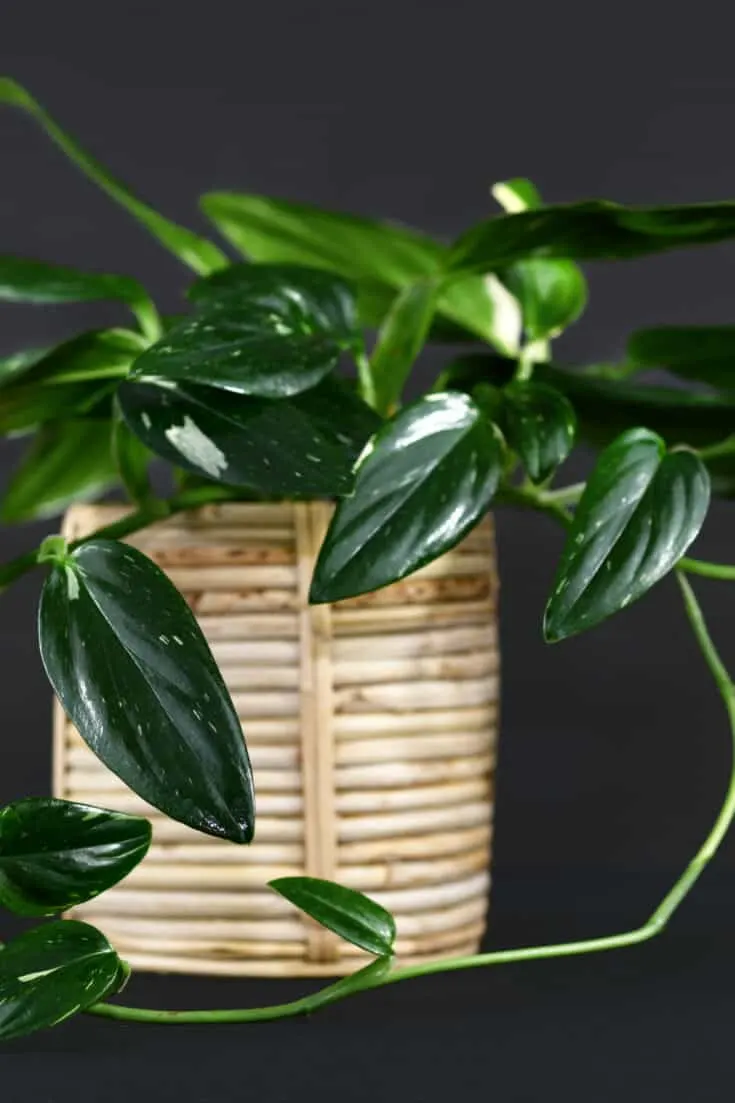
Monstera Standleyana is a climber that grows best in bright indirect light
Watering
Watering a Monstera standleyana is like most other plants. It needs water on the regular about once a week on average when the top 2” (5cm) of soil dry out.
But you don’t want to over-water it either.
For the best results, you need to use a pot with plenty of drainage holes on the bottom.
Self-draining pots mean less work for you.
You don’t have to keep switching out soil when it has too much moisture.
When you water your plant, check the soil first. Stick your finger into the soil, up to your knuckle.
If the soil is still moist, don’t water it yet. If the soil is dry, go ahead and water it.
Don’t let the soil dry out before watering. This is a big no-no.
When you do water your plant, use enough water that all the soil is wet but not soaked.
Even with well-draining soil, it can take a while for the water to drain if there’s too much in the soil.
You need to water your Monstera standleyana about once a week during the cold months.
During the warmer months, you need to water your plant about two to three times a week.
Temperature
The best temperature range for a Monstera standleyana is between 65°F and 80°F (18 – 27°C).
Since the plant originates from warm climates, they prefer warmer temperatures.
Avoid going below 65F (18°C). This will either slow or stop your plant from growing.
Humidity
The Monstera standleyana thrives off of humidity of 50% and more.
It mimics their original homes.
There are two main ways to achieve humidity for your plant.
First, there’s the pebble tray method that we love so much.
You fill a tray full of pebbles. Then you fill the tray with water but make sure the water doesn’t go above the pebbles.
Place your plant’s pot on top of the pebbles. As the water evaporates, it creates humidity.
Since you’ll probably be using a hanging pot, the first method might not be the best one for you.
Your second option is to mist the plant with a spray bottle. You’ll want to spray the leaves with water a few times a week.
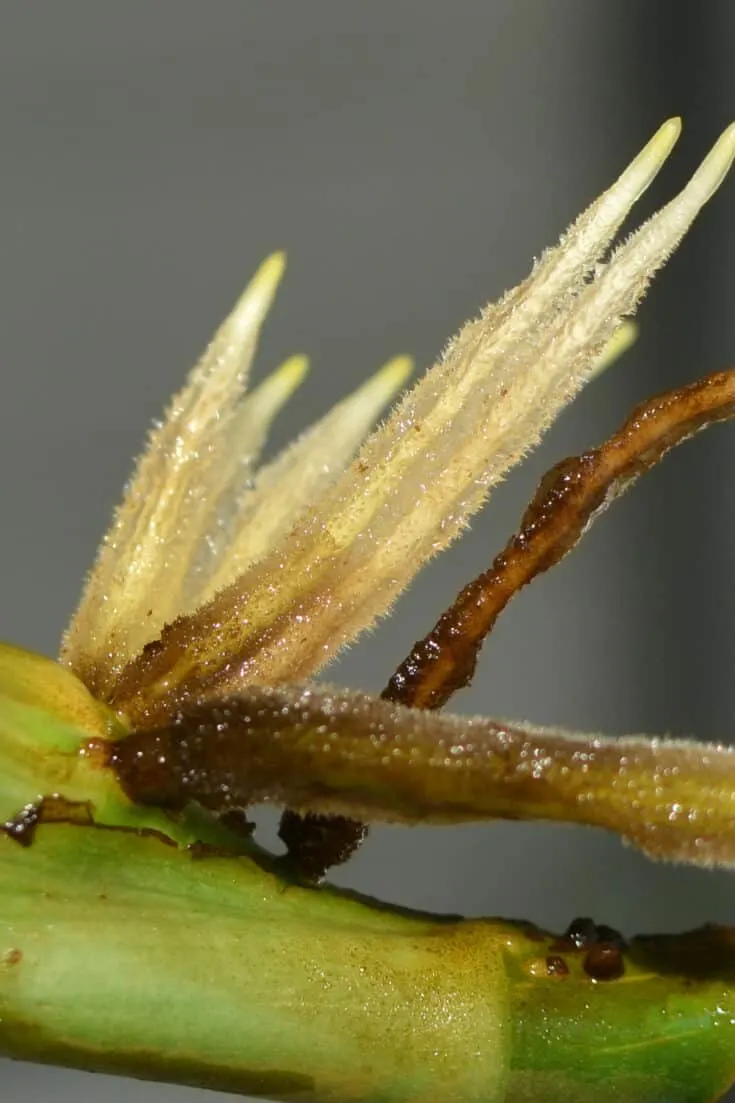
Monstera Standleyana will grow fuzzy roots in high humidity
Fertilizer
Fertilize Monstera standleyana using a balanced fertilizer for indoor plants once a month in spring and summer.
If you’re worried about the fertilizer being too much, you can always dilute it.
During the summer months, you should fertilize your plant once a month. But don’t fertilize during the winter months.
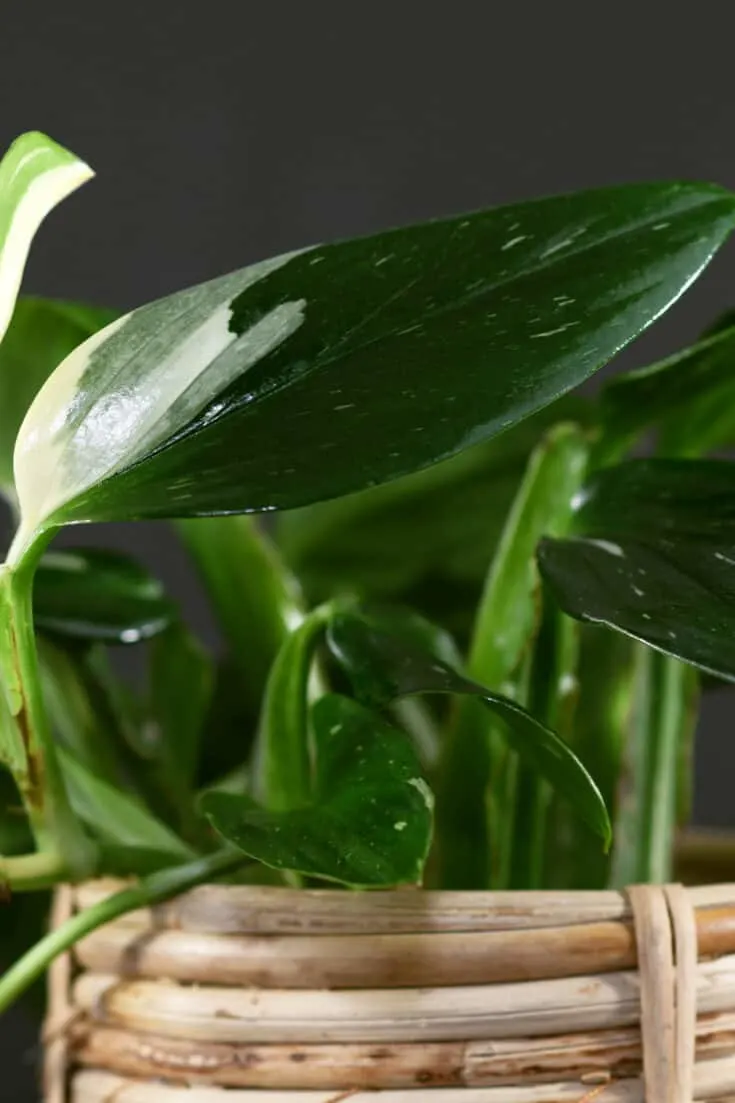
Monstera Standleyana should be fertilized once a month in the growing season
Propagation
To propagate a Monstera standleyana, you’ll need a stem cutting.
This plant propagation should only be done during spring.
We’ll go into more details below!
Growth
The runner or vines of the Monstera standleyana can grow up to a whopping 20 feet. But they only get this big in areas where they can continue to grow straight up.
On average, an indoor Monstera standleyana grows between two and five feet. The width of the plant gets to be about two to three feet.
The leaves can grow to six to nine inches in length. And they grow about five inches in width.
Potting
The Monstera standleyana has roots that grow fast. Because of this, you’ll need to re-pot your plant once a year during spring.
Every year you’ll notice roots growing out of the drainage holes of the pot. Or the roots might even grow in a circle. These are definite signs that it’s time to re-pot.
Re-potting one of these plants is easy. Don’t get a pot that’s too much bigger than the one it’s in already. Or you might stress the roots out.
Instead, the new pot should be only one size bigger than the pot you’re moving it from.
Monstera standleyana Propagation Steps
The perfect time to propagate a Monstera standleyana is during springtime, particularly March. Any other time of the year is either too cold or too hot for proper growth.
Stem cuttings are the way to go. We’re going to go through the steps of propagating your Monstera standleyana.
- It’s time to get your stem cutting ready! For a Monstera standleyana, your cutting is going to be a little bigger than for other plants. Cut six to eight inches from the stem tip of your grown plant. The best cutting will have at least two leaf nodes and two leaves. But you don’t want more than two leaves on your cutting. Remove leaves from the bottom of the cutting or the end that’s going in the soil. Aerial roots attached to it is a must.
- Next, you want to lay your stem cutting out for about a week in a warm area. This will form a callous on the bottom of the cutting. A calloused end can boost rooting.
- While your Monstera standleyana stem cutting is sitting out, you can get the pot ready. The pot should be self-draining with drainage holes at the bottom. The soil should be well-draining, like your original plant. It should also be moist when you go to plant the cutting.
- Once the week is up, it’s time to plant the stem cutting. You’re almost done. Stick the stem cutting about two to three inches into the soil. The bare node and aerial roots should be under the soil as well.
- If your cutting isn’t able to support itself right away, try tying it to a straw to hold it up.
- You’re done with all the hard work. It’s time to place the cutting in indirect sunlight and take care of it as you would a grown Monstera standleyana. It can take anywhere from a week to a month for the rooting to start. And it takes about a month for shoot development.
Other Varieties of the Genus Monstera
The Monstera standleyana isn’t the only Monstera plant. There are a few different species of this tropical genus.
This plant has large leaves filled with large holes. It’s the most popular Monstera species thanks to its’ beauty.
This Monstera is one of our favorites. Like the Monstera standleyana, it has variegated leaves. The variegated part of the leaves turns a bright white.
The Monstera dubia is a rare plant. The leaves are heart-shaped and it’s a climbing vine plant.
It has smaller thick leaves but bigger holes, giving it a unique look. The leaves are rough to touch.
This plant is another rare Monstera. There’s hardly any leaf because the holes are so big.
Common Problems with the Monstera standleyana
There are a few pests that like to attack plants like the Monstera standleyana.
You always have to be on the lookout because the faster you get rid of them, the better for your plant.
Aphids are one common and annoying pest that can invade your plant. These bugs will suck the sap and nutrients out of it.
There are several different species of aphids to top it off.
It’s important to get rid of aphids right away. If they multiple, there are more mouths stealing nutrients from your plant.
If your Monstera standleyana is covered in sap, it’s a sign that aphids are feeding off your plant’s nutrients. That sap isn’t exactly sap but the waste after a bug has fed.
This is the biggest sign of an aphid bug invasion.
On the bright side, they’re easy to get rid of. There are a few ways but we’re going to share the most effective method we’ve found to get rid of them.
Spray your Monstera standleyana with cold water to wash away most of the aphids.
Then wash the plant with insecticidal soap to get rid of the rest of these ugly green things.
You’ll have to wash your plant for about two days a week for two weeks.
Spider mites are another common pest for the Monstera standleyana. Spider mites aren’t bugs but rather they’re an arachnid. Creepy, right?
They hide underneath leaves and steal the plant’s nutrients. You’ll see light brown spots, which are their feeding spots.
To get rid of spider mites, you need to trim any infected parts of the plant that are too far gone to fix.
Once that’s done, wash your plant with insecticidal soap. You’ll have to wash it two days a week for two weeks like with the aphids.
Tips for an Unhappy Monstera standleyana
If your Monstera standleyana isn’t thriving the way it should be, don’t panic yet. Most situations are fixable with some tender loving care.
Your Monstera standleyana’s Leaves Are Yellow or Brown
When your Monstera standleyana has yellow and brown leaves, you’re over-watering.
You’ll want to check the roots too to make sure your plant isn’t developing wet feet or rotting.
Make sure the soil is completely dry next time you water your plant. In some cases, the soil will take too long to dry so you’ll have to replace it instead.
Your Monstera standleyana’s Leaves are Wilting
Wilting leaves look scarier than they are. This can mean that you’re either over-watering or not watering your plant enough.
To find out which one is the problem, check the soil. Always check the soil.
When the soil is too wet, wait until it’s completely dry to water again. When the soil is dry, water your Monstera standleyana right away.
Your Monstera standleyana Has Brown Spots Circled with Yellow
Those ugly brown spots with yellow circling them are a sign of a fungus. Your Monstera standleyana is too wet.
A fungus is created by wet environments and they thrive in the same type of environments.
Dry your plant out and make sure there’s enough air circulation in the room.
Then you’ll have to remove all the fungus-infected leaves for the plant. Dispose of them right away.
Your Monstera standleyana’s Young Leaves are Black Before They Unfurl
It’s a strange sight to see black leaves, especially when the leaves are still young. And they haven’t even unfurled yet.
This is another sign of either over-watering or under-watering. You have to check the soil to determine which one is your problem.
Then water your Monstera standleyana accordingly.
Frequently Asked Questions About Monstera standleyana
What colours do the variegation leaves on the Monstera standleyana turn?
They turn either cream, white, or yellow. The designs can be spots or stripes.
Why doesn’t my Monstera standleyana’s leaves have holes?
What’s wrong with your Monstera standleyana depends on how old your plant is. An older plant with is stressed out. A young plant with no holes just might not have developed their holes yet.
Can a Monstera standleyana live in water?
A Monstera standleyana can live in water. But it’s a difficult process and you’ll need to do the extra work for your plant to thrive. For about every gallon of water, you’ll need a teaspoon of fertilizer.
Is the Monstera standleyana toxic?
The Monstera standleyana is toxic to humans. You should avoid ingesting it. It’s also toxic to animals so keep it away from your pets.
Conclusion About Monstera standleyana Care
The Monstera standleyana is one of the most colourful Monstera plants you can get.
Its leaves are very distinct and different from the others.
It is less common than the Monstera Deliciosa and Monstera Adansonii but another aroid that is great to care for. So if you see one, buy it.
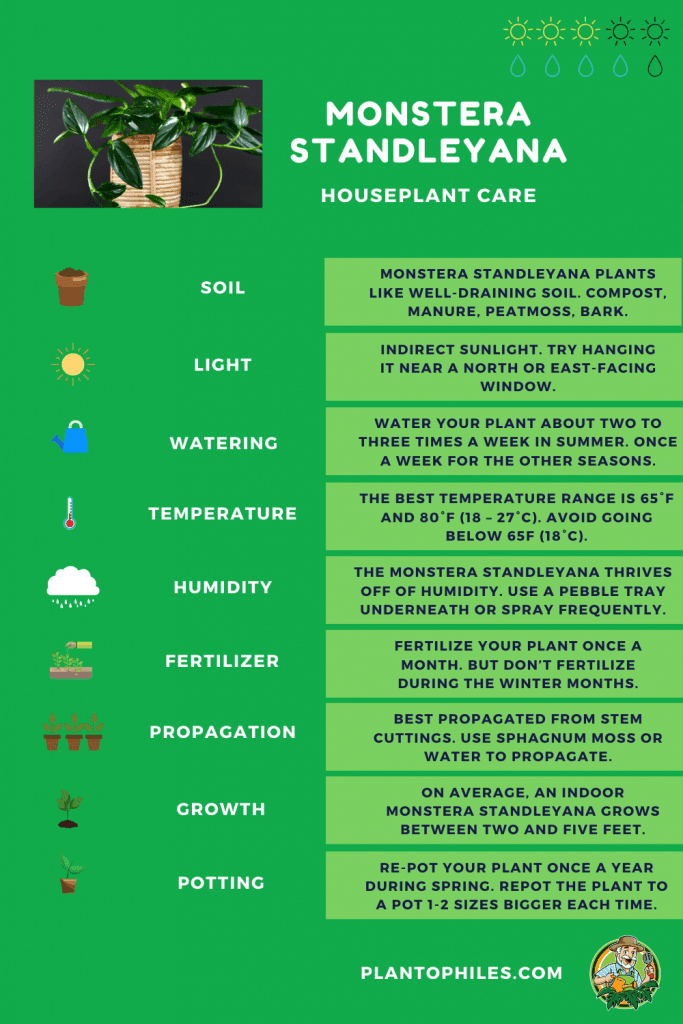
Monstera standleyana Philodendron Cobra Care Sheet.

Daniel has been a plant enthusiast for over 20 years. He owns hundreds of houseplants and prepares for the chili growing seasons yearly with great anticipation. His favorite plants are plant species in the Araceae family, such as Monstera, Philodendron, and Anthurium. He also loves gardening and is growing hot peppers, tomatoes, and many more vegetables.

